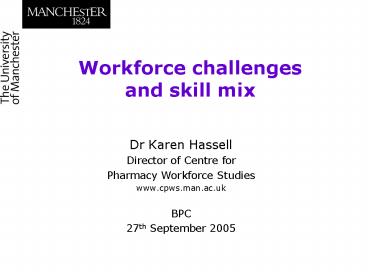Dr Karen Hassell - PowerPoint PPT Presentation
1 / 15
Title:
Dr Karen Hassell
Description:
ie, changing skill mix (enhancement; innovation) The evidence base? ... Advanced basic training ... 'There is also a stark contrast within. pharmacy in terms of ... – PowerPoint PPT presentation
Number of Views:16
Avg rating:3.0/5.0
Title: Dr Karen Hassell
1
Workforce challenges and skill mix
- Dr Karen Hassell
- Director of Centre for
- Pharmacy Workforce Studies
- www.cpws.man.ac.uk
- BPC
- 27th September 2005
2
Outline
- Policy background and drivers for change
- What is skill mix
- The evidence base
- Challenges in implementing skill mix
3
Policy
- liberate the talent skills of all the
workforce so that every patient gets the right
care in the right place at the right time. - From Delivering the NHS Plan, 2002
4
What is/should the pharmacy workforce be doing?
- Dispensing supply roles
- Medicines management
- Supplementary prescribing
- Supporting self-care and OTC use
- Dispensing repeat prescriptions
- Smoking cessation
- Sexual health services
- Patient safety
5
Who is there to do these things?
- Pharmacists
- 23,500 community pharmacists (2003, GB)
- 7,000 hospital pharmacists (2003, GB)
- 2,600 PC pharmacists (2003, GB)
- Other staff
- 5,000 hospital technicians (2001, England)
- 8,500 community pharmacy technicians
- 22,500 dispensing assistants
- 40,000 MCAs
6
Are there enough?
- Staff shortages
- Best estimates suggest a shortage of 1700
pharmacists - Increasing demand for staff
- Recruitment and retention problems
7
Drivers for change
- Pharmacist shortages
- Increasing workload
- Legislation/regulation
- Technological innovation
- Quality improvement?
- Cost containment?
8
Whats the solution?
- More staff
- Same staff with new skills or roles
- Different staff with different roles
- ie, changing skill mix (enhancement innovation)
9
The evidence base?
- Skill mix abroad
- Review of evidence of skill mix initiatives in
community pharmacy in GB - Feasibility survey of support staff
- Observation study of the activities and roles of
support staff
10
Lessons from abroad
- Advanced basic training
- Political drive
- Clarity over division of labour and organisation
of work - Size of organisation
- Strong systems approach common
- Long-range supervision the norm
Source Skill mix review, 2002 (DH)
11
Closer to home
- People generally unfamiliar with the terminology
- General consensus for making better use of
pharmacy support staff extending their roles - Divided views concerning what pharmacists should
do with time freed up. A key barrier being that
workload is highly variable and unpredictable - Other barriers to implementation
Hassell et al, Skill mix review, DoH, 2002
12
Barriers to implementation
- Physical/environmental
- The political/legislative framework
- The workforce itself
- lack of shared vision
- capacity/availability of staff
- aspirations and attitudes are varied
- no clarity about tasks/roles
13
- There is also a stark contrast within
- pharmacy in terms of the skills and
- educational profile of different staff, yet a
substantial overlap in terms of the tasks
performed
Hassell K, Shann P, Noyce P (2002) Pharm J, 269
851-4
14
The reality
- Some pharmacies operate without a PT (47) or DA
(16) - Highly feminised workforce
- Generally a very experienced workforce
- but dichotomised in terms of educational
background and future aspirations - Recruitment and retention issues apply
Source Feasibility study on deployment of
support staff, Sept. 2004 (DH)
15
Finally, whats needed to make it work?
- Clarity of vision shared vision
- Professional regulation/legislation
- Education and training to underpin change
- Incentives to train, and suitable recognition for
additional qualifications or accreditation - One model not sufficient









![download⚡[PDF]❤ The Killing of Karen Silkwood: The Story Behind the Kerr-McGee Plutonium Case PowerPoint PPT Presentation](https://s3.amazonaws.com/images.powershow.com/10041837.th0.jpg?_=202405290812)













![❤[READ]❤ I Saw That!: Funny Sarcastic Karen Meme Novelty Lined Notebook For Friends, PowerPoint PPT Presentation](https://s3.amazonaws.com/images.powershow.com/10064945.th0.jpg?_=20240626111)







